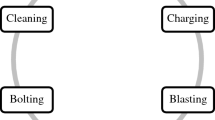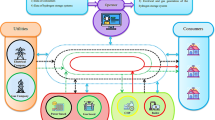Abstract
We present a novel mathematical algorithm to assist gas network operators in managing uncertainty, while increasing reliability of transmission and supply. As a result, we solve an optimization problem with a joint probabilistic constraint over an infinite system of random inequalities. Such models arise in the presence of uncertain parameters having partially stochastic and partially non-stochastic character. The application that drives this new approach is a stationary network with uncertain demand (which are stochastic due to the possibility of fitting statistical distributions based on historical measurements) and with uncertain roughness coefficients in the pipes (which are uncertain but non-stochastic due to a lack of attainable measurements). We study the sensitivity of local uncertainties in the roughness coefficients and their impact on a highly reliable network operation. In particular, we are going to answer the question, what is the maximum uncertainty that is allowed (shaping a ’maximal’ uncertainty set) around nominal roughness coefficients, such that random demands in a stationary gas network can be satisfied at given high probability level for no matter which realization of true roughness coefficients within the uncertainty set. One ends up with a constraint, which is probabilistic with respect to the load of gas and robust with respect to the roughness coefficients. We demonstrate how such constraints can be dealt with in the framework of the so-called spheric-radial decomposition of multivariate Gaussian distributions. The numerical solution of a corresponding optimization problem is illustrated. The results might assist the network operator with the implementation of cost-intensive roughness measurements.



Similar content being viewed by others
References
Ben-Tal A, El Ghaoui L, Nemirovski A (2009) Robust optimization. Princeton University Press, Princeton
Brauchart J, Saff E, Sloan I, Womersley R (2014) QMC designs: optimal order Quasi Monte Carlo integration schemes on the sphere. Math Comput 83:2821–2851
Chertkov M, Misra S, Vuffray M (2015) Monotonicity of dissipative flow networks renders robust maximum profit problem tractable: general analysis and application to natural gas flows. Math Optim Control. arXiv:1504.00910 [math.OC]
Colebrook C (1939) Turbulent flow in pipes with particular reference to the transition region between the smooth and rough pipe laws. J Inst Civ Eng I1:133–156
Déak I (2000) Subroutines for computing normal probabilities of sets-computer experiences. Ann Oper Res 100:103–122
Dentcheva D, Ruszczyński A (2003) Optimization with stochastic dominance constraints. SIAM J Optim 14(2):548–566
Egger H, Kugler T, Strogies N (2017) Parameter identification in a semilinear hyperbolic system. IOPsci Inverse Probl 33(5):055022
Genz A, Bretz F (2009) Computation of multivariate normal and t-probabilities, vol 195. Lecture notes in statistics. Springer, Heidelberg
Gill P, Murray W, Wright M (1981) Practical optimization. Academic Press, Cambridge
Gotzes C, Heitsch H, Henrion R, Schultz R (2016) Feasibility of nominations in stationary gas networks with random load. Math Methods Oper Res 84:427–457
Gotzes C, Nitsche S, Schultz R (2017) Probability of feasible loads in passive gas networks with up to three cycles. Preprint, available online at OPUS TRR154
Koch T, Hiller B, Pfetsch M, Schewe L (2015) Evaluating gas network capacities, MOS-SIAM series on optimization, vol 21. SIAM, Philadelphia
Pfetsch ME, Fügenschuh A, Geißler B, Geißler N, Gollmer R, Hiller B, Humpola J, Koch T, Lehmann T, Martin A, Morsi A, Rövekamp J, Schewe L, Schmidt M, Schultz R, Schwarz R, Schweiger J, Stangl C, Steinbach MC, Vigerske S, Willert BM (2015) Validation of nominations in gas network optimization: models, methods, and solutions. Optim Methods Softw 30(1):15–53. doi:10.1080/10556788.2014.888426
Prékopa A (1995) Stochastic programming. Kluwer, Dordrecht
Van Ackooij W, Henrion R (2014) Gradient formulae for nonlinear probabilistic constraints with Gaussian and Gaussian-like distributions. SIAM J Optim 24:1864–1889
Van Ackooij W, Henrion R (2017) (Sub-) Gradient formulae for probability functions of random inequality systems under Gaussian distribution. SIAM/ASA J Uncertain Quantif 5:63–87
Van Ackooij W, Frangioni A, de Oliveira W (2016) Inexact stabilized Benders’ decomposition approaches with application to chance-constrained problems withfinite support. Comput Math Appl 65:637–669
Acknowledgements
The authors thank the Deutsche Forschungsgemeinschaft for support within project B04 in the Sonderforschungsbereich/Transregio 154 ’Mathematical Modelling, Simulation and Optimization using the Example of Gas Networks’. Additionally, the first author expresses her gratitude to the SFB TRR 154 Integrated Graduate School.
Author information
Authors and Affiliations
Corresponding author
Rights and permissions
About this article
Cite this article
González Grandón, T., Heitsch, H. & Henrion, R. A joint model of probabilistic/robust constraints for gas transport management in stationary networks. Comput Manag Sci 14, 443–460 (2017). https://doi.org/10.1007/s10287-017-0284-7
Received:
Accepted:
Published:
Issue Date:
DOI: https://doi.org/10.1007/s10287-017-0284-7




